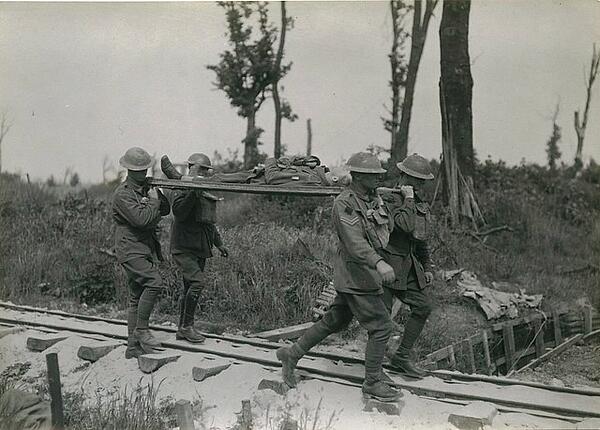Battles of the Ypres Salient
Ypres and the surrounding Ypres Salient played a key role on the Western Front and are known around the world for their part in World War One. The continued hold of Ypres and its outer regions by the Allies throughout the war meant the Allied nations managed to keep a gap between them and the advancing German Army as it moved towards Paris.
There were a number of key battles fought in and around Ypres during the war, including the Battle of Ypres, the Battle of Passchendaele and the Third Battle of Ypres. It was also within easy reach of Poperinge, which became something of a hub of rest for the Allied soldiers and ensured they maintained concentration and resolve throughout the war. Without having a strong hold over Ypres, the Allies arguably may not have seen such a positive outcome.

1914
First Battle of Ypres – October to November
October - the front line extended from Langemark, Zonnebeke, Gheluvelt, Zandvoorde, Messines to Armentières. The British Expeditionary Force held the eastern and southern sectors, while the French were on their left and the Belgium Army to the north.
October 7th: German troops entered Ypres but stayed for just a short time as Allied troops were arriving in force.
October 13th: The Northumberland Hussars arrived at Ypres. In the previous day they had seen action in Bruges – the first British TA unit to do so in World War One.
October 14th: A much larger British and French force arrived in Ypres. The British force was the IV Corps led by the 7th Division. IV Corps headquarters was at a convent in Poperinge while its advance HQ was at the Hotel de Ville in Ypres. The lack of space there meant that part of the Cloth Hall was also used. General Henry Rawlinson, commander of IV Corps, was billeted in Ypres.
October 22nd: The Germans started their concentrated attack on Ypres.
October 29th: The front line had contracted towards Ypres with places such as Zonnebeke falling to the Germans advance.
October 31st: The Germans were pushed out of Gheluvelt.
November 1st: The Germans captured Messines-Wytschaete Ridge.
November 2nd: The British 1 Corps and French XIV Corps held off a major German attack on Gheluvelt.
November 10th: The Germans second major artillery attack on Ypres started.
November 22nd: The historic Cloth Hall and St. Martin’s Church were badly damaged as a result of this bombardment.
1915
January: The front line stood at Bikschote, Langemark, St. Julien, Broodseinde, Hooge, Zillebeke, St. Eloi, Wytschaete and Ploegesteert. Despite almost continuous fighting in the winter months, the line barely moved.
March: The civilian population of Ypres started to return to the town after the previous year’s artillery bombardment.
April to June: Second Battle of Ypres.
April 14th: The Germans started an artillery bombardment of the town that lasted nearly a month. Most of the town was destroyed.
April 17th: British troops captured Hill 60.
April 22nd: The first poisonous gas attack of World War One occurred at Bikschote against French troops. Belgium and Canadian troops helped the French hold their line.
April 25th: The Germans started their main attack against British positions.
May: Heavy fighting occurred throughout the month and both sides suffered heavy casualties.
May 5th: Hill 60 was attacked by the Germans and British forces were pushed back.
July 22nd: British forces advanced along the Menin Road, near Hooge.
July 29th: The first recorded use of a flame-thrower took place.
August 7th: A German gas attack on Allied forces at Hooge took place.
1916
Hill 62 was captured by the Canadian Corps. They also stopped the German advance on Zillebeke and Hooge and got within 1000 meters of Hill 60. However, in this year, the front line mostly stayed static.
1917
Battle of Messines
June 1st: The British started their offensive with a massive and prolonged artillery attack. Both Messines and Wytschaete were extensively damaged.
June 7th: Nineteen mines exploded along the front line – from Hill 60 to Messines. The New Zealand Division captured Messine Ridge.
June 11th: The Allies advanced two miles beyond the old front line. German counter-attacks were ineffective.
Third Battle of Ypres, July – November
July 31st: The Allies started their offensive against German lines. At Bikschote, the Allies advanced two miles beyond German trenches.
August 1st: Sanctuary Wood, Hooge, Pilkem and St. Julien all fell after severe fighting.
August 16th: The Allied offensive resumed along the whole front line. The advance continued until September 20th.
September 20th: Langemark and Zonnebeke were attacked and many fortified farmhouses and trenches were captured. Australian forces attacked Polygon Wood.
September 26th: Polygon Wood fell to the Australians. Tower Hamlets fell to British troops.
October 4th: The offensive was continued though German resistance became more and more determined.
October 9th: The British frontline extended seven miles but casualties on both sides were very high.
October 30th: Passchendaele Ridge was finally cleared of all German forces.
November 6th: Passchendaele was taken by the Allies.
1918
April 9th: The German Spring Offensive started. During the next two weeks, the Germans recaptured much territory lost in the Third Battle of Ypres.
July 19th: The start of the Battle of Lys when British forces attacked German positions.
August: The Allies counter-attacked the Germans who had overstretched their supply lines. German shock troops had advanced so far ahead of their supply lines that they could not be rearmed etc.
October 14th: The last artillery shell fell on Ypres as German troops were forced out of the Ypres Salient.
At the end of the war, Ypres was awarded the Military Cross from Great Britain and the Croix de Guerre from France.
MLA Citation/Reference
"Battles of the Ypres Salient". HistoryLearning.com. 2026. Web.
